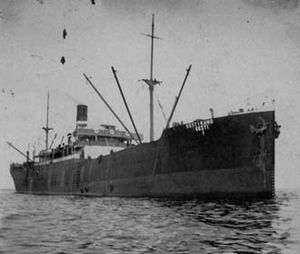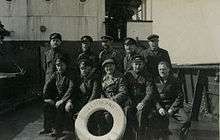Eestirand
SS Eestirand (Estonian Coast), built in 1910, was an Estonian steel-hulled cargo steamship. She was one of the largest ships in her class at the time and served as the mother-ship of the first Estonian herring expeditions in the 1930s.[1] In World War II she served as a Soviet Navy transport vessel and was subsequently sunk in 1941 near Prangli Island during the Soviet evacuation of Tallinn.
 Eestirand at sea, circa 1932 | |
| History | |
|---|---|
| Name: | |
| Owner: |
|
| Builder: | |
| Launched: | 1932 (As Eestirand) |
| Completed: | 1910 |
| Acquired: | 12 May 1932 (As Eestirand) |
| Out of service: | 24 August 1941 |
| Fate: | Sunk 24 August 1941 by German aircraft |
| General characteristics | |
| Tonnage: | 4,377 GRT |
| Length: | 376.5 ft (114.8 m) p/p |
| Beam: | 52.2 ft (15.9 m) |
| Draught: | 23 ft (6.9 m) |
| Depth: | 25.5 ft (7.8 m) |
| Installed power: | 320 NHP |
| Propulsion: | triple-expansion steam engine |
| Speed: | 9.5 kn (10.9 mph) |
History

The ship was built in 1910 by Archibald McMillan & Son Ltd. in Dumbarton, Scotland and launched as Starthardle for the Burrell & Son Steamship Line.[2] in Glasgow In 1916 the Scottish-American shipping magnate Robert Dollar bought her for his Dollar Steamship Lines. Renamed Harold Dollar, she worked between New York City and Asia.[3]
In 1932 the Estonian Fishing Co. bought the ship, then called Glenbeath, from the Waverley Shipping Company in Sunderland, Tyne and Wear, United Kingdom for £7,500 pounds sterling. She came to the Estonian port of Tallinn on 12 May where she was renamed Eestirand and refitted for the fishing trade. At the time she was the largest ship in the Estonian merchant fleet.[1]
The ship made her maiden voyage as Eestirand on 9 June 1932 under captain Jakob Lepni, with a crew of 142 men and women. She served as the mother ship for the first Estonian herring expedition off the coast of Iceland and took in her first herring catch on 7 July.[1] After its return to Tallinn on 15 September with its cargo, the expedition was considered a success, with Estonian fish exports now exceeding imports. Eestirand continued to serve as the flagship for the Estonian fishing industry until she was requisitioned into the Soviet Navy during the Soviet occupation of the Baltic states.
Service in World War II
In World War II Eestirand was recommissioned into the Baltic Fleet as VT-532 in 1941. Her primary role was transporting troops and war materiel in the heavily-mined Baltic Sea. As German troops advanced on Tallinn in August 1941, the Soviets began preparations for evacuation. Eestirand would be part of a convoy or ships responsible for the evacuation of Soviet military personnel and Estonian conscripts to Kronstadt to help relieve the German siege of Leningrad.[4]
On 24 August 1941 Eestirand came under attack from German planes as she neared the Keri Lighthouse on Keri Island.[5] 44 men were killed in the bombardment, and many more drowned after falling overboard.[4] The commander of the evacuation fleet, Vladimir Tributs, ordered Eestirand's captain, Boris Nelke, to continue to Kronstadt. Ignoring the order, Nelke instead chose to head to Prangli Island, about 6 kilometres (3.2 nmi) to the south, and beach the badly damaged ship off the shore of the island.
Once grounded, Nelke and his crew helped the 2,700 surviving Estonian conscripts to disarm the Soviet military personnel aboard the ship and escape onto the island and avoid mobilization to Leningrad.
In 1946 the wreck of Eestirand was raised and towed to Kopli Bay for scrapping.
Monument
After the war a monument was erected on Prangli Island to honor the passengers and crew of Eestirand who were killed on that voyage. The monument includes a large 4-metre (13 ft)-high wooden cross with the inscription "Eestirand 24–08–41", adorned with a life preserver from the ship. The original anchor was salvaged from the wreck and set in concrete at the foot of the cross. 42 smaller white wooden crosses stand for those killed in the attack.
A central granite pedestal bears a plaque which reads (translated from Estonian):
"Here at Prangli Island off the coast of Keri on 24 and 25 August 1941, the steam ship Eestirand was lost to bombing of German aircraft. For dozens of Estonians and Russian Jews it was their last sea voyage."
References
- Sammet, Jaak (1993). Estonian Herring Expeditions 1932–1937 (PDF). Stavanger Museum. Archived from the original (PDF) on 13 December 2014. Retrieved 11 December 2014.
- Cage, R. A. (1997). A tramp shipping dynasty--Burrell & Son of Glasgow, 1850-1939. Greenwood Publishing Group. p. 170. ISBN 9780313303463. Retrieved 9 December 2014.
- Greater New York: Bulletin of the Merchants' Association of New York. 9. New York: The Association. 1920. p. 12. Retrieved 9 December 2014.
- Kriss, Tiina (2009). Estonian Life Stories. Central European University Press. p. 130. ISBN 9789639776395. Retrieved 9 December 2014.
- Taylor, Neil (2014). Bradt Travel Guide: Estonia. Bradt Travel Guides. p. 128. ISBN 9781841624877. Retrieved 9 December 2014.

